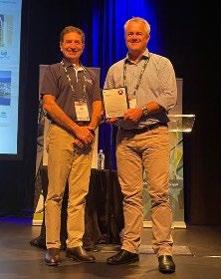ASSET MANAGEMENT
BRIDGING THE GAP BETWEEN ENGINEERING AND ACCOUNTING
Jacqueline Perkowicz, Strategic Project Officer, Mareeba Shire Council
Mareeba Shire Council has introduced a new teambased asset management framework to resource and fund the inspection, maintenance and replacement of bridges and major culverts. With many aging bridges needing replacement and limited resources, a team of operational and management staff has collaborated to ensure the Shire’s bridges remain safe and functional. The Mareeba Shire Bridges Asset Management Project was an initiative that unified accounting and engineering professionals into a team with a shared goal that resulted in a safe and functional bridge portfolio with no increase in budget. The reality is that the differing views and priorities between the accounting and engineering professions can lead to communication breakdown. However, taking advantage of these characteristics and focussing on a shared goal has provided maximum value for Mareeba Shire Council and the broader community. Mareeba Shire’s $67M bridge, major culvert and causeway
46
portfolio is dispersed over 53,457km2. With only one crew available to inspect, maintain and complete capital renewal projects, it seemed evident that there were insufficient resources to manage the portfolio. Like many councils, Mareeba has an aging asset portfolio, limited resources and minimal capacity to increase rates. Also, when Mareeba Shire de-amalgamated in 2014, it was assessed by Queensland Treasury Corporation as having a financial outlook of ‘very weak with a negative outlook’. Before the project commenced, aside from a handful of outsourced specialist consultant reports, the bridge and major culvert network’s remainder had not had a recent properly recorded engineering inspection. Of the 23 bridges selected for an outsourced specialist consultant report, 15 were reported to be in poor or deplorable condition and at risk of catastrophic failure. As part of the Long-Term Asset Management Plan development, it was identified that a team approach would reduce the risk of silos being created and ensure that specialist skills are brought together effectively. Within the Long-Term Asset Management Plan, Asset Management framework sub plans were identified for development as stand-alone projects. As a critical asset class with a catastrophic consequence of failure, the Bridges Asset Management Plan Project was prioritised for development. The Bridges Asset Management Project’s success has been mainly due to project planning, control and flexibly engaging relevant
stakeholders. A project plan was developed to capture the requirements of all stakeholders and document the actions required to achieve the output of individual asset management plans and the identified project outcomes. A project steering group named the Asset Management Group was formed, comprising key asset management staff and the senior operational and financial management team. The project steering group meets monthly to review progress and identify new issues. A small bridges asset management subgroup was formed to identify and resolve bridge asset management problems. Creating smaller subject matter expert subgroups to focus on specific issues has allowed the project to progress much more quickly and efficiently than would otherwise be possible and has also enabled the successful model of reporting achievements to the AM Group, which is then able to provide an oversight function. The community expects that bridges, causeways and major culverts are constructed and maintained to be safe for the public. For many councils, including Mareeba Shire Council, resources available to carry out proactive and reactive maintenance and capital renewals are limited. In Mareeba Shire, there is one crew responsible for inspections, maintenance, capital renewal and upgrade construction projects for bridges, major culverts and causeways and all general concrete work, including footpath construction. This
ENGINEERING FOR PUBLIC WORKS | MARCH 2021



























